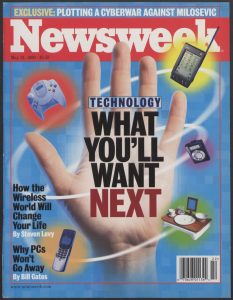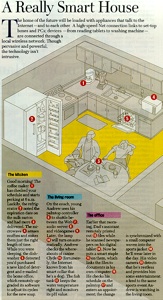The year was 1999, the month was May, and Newsweek (an American weekly news periodical) had a cover feature entitled “What You’ll Want Next”. The cover prominently featured a Sega Dreamcast controller (the console was slated for U.S. release a few months later). One of the features in the issue had an illustration of a future home and all the technological marvels that would arrive in coming years. I scanned the pictures and always wanted to write something about the prognostications contained within, some of which seemed a tad outlandish.

May 31, 1999 Newsweek magazine: “What You’ll Want Next” (cover found at: Yale Library Digital Collections)
I never got around to it at then (plus, I had no good place to publish it). But look at the time– it’s 10 years later already! And I still have the page scans laying around, having survived moves to at least a 1/2 dozen “main desktop computers” over the intervening decade. So let’s have a look at where we were supposed to be by now.

|

|
Click for larger images
A Really Smart House
The home of the future will be loaded with appliances that talk to the Internet — and to each other. A high-speed Net connection links to set-top boxes and PCs; devices — from reading tablets to washing machine — are connected through a local wireless network. Though pervasive and powerful, the technology isn’t intrusive.
